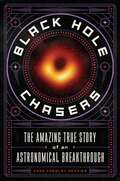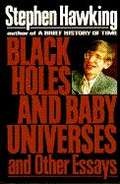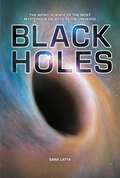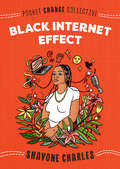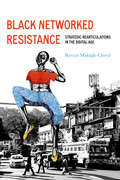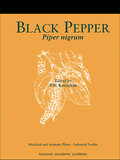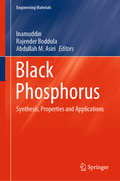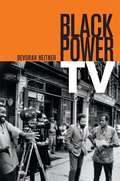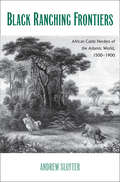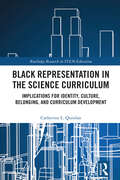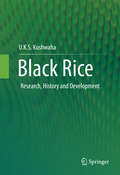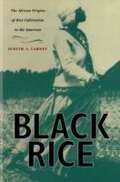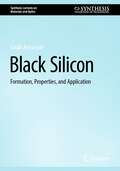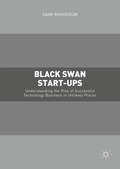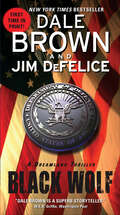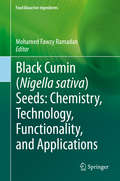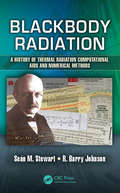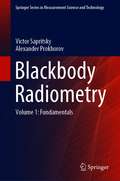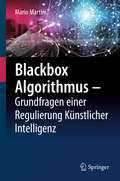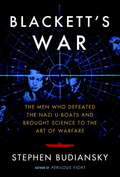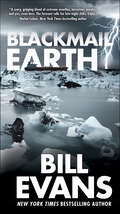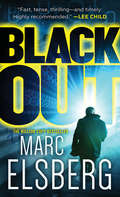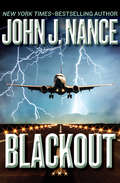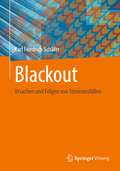- Table View
- List View
Black Hole Chasers: The Amazing True Story of an Astronomical Breakthrough
by Anna Crowley ReddingIn Black Hole Chasers, award-winning investigative journalist Anna Crowley Redding presents the riveting true story of one of the most inspiring scientific breakthroughs of our lifetime—the Event Horizon Telescope team's reveal of the first image of a super massive black hole.In April 2019, the Event Horizon Telescope Team unveiled the first ever image of a super massive black hole.This inspiring scientific breakthrough took years of hard work, innovative thinking, and a level of global cooperation never seen before. The challenge was immense. The goal was impossible. They would need a telescope as big as the earth itself. The technology simply didn’t exist. And yet, a multi-national team of scientists was able to show the world an image of something previously unseeable.Based off extensive research and hours interviews with many of the team's ground-breaking scientist, physicists, and mathematicians, Black Hole Chasers is a story of unique technological innovation and scientific breakthroughs, but more importantly, it's a story of human curiosity and triumph.
Black Holes and Baby Universes
by Stephen HawkingThese thirteen essays and an extended BBC interview range from the autobiographical to the purely scientific. Hawking discusses imaginary time, black holes, and the Grand Unified Theory.
Black Holes: The Weird Science of the Most Mysterious Objects in the Universe
by Sara LattaIn 2015 two powerful telescopes detected something physicists had been seeking for more than one hundred years—gravitational waves from the collision of two black holes. This announcement thrilled the scientific community. Since the eighteenth century, astronomers have predicted the existence of massive, invisible stars whose gravity would not let anything—even light—escape. In the twenty-first century, sophisticated technologies are bringing us closer to seeing black holes in action. Meet the scientists who first thought of black holes hundreds of years ago, and learn about contemporary astrophysicists whose work is radically shaping how we understand black holes, our universe, and how it originated.
Black Internet Effect (Pocket Change Collective)
by Shavone Charles"This frank, spirited guide spotlights a thoughtful leader who embraces social responsibility." — KirkusWith witty humor and a strong sense of self, musician, model, and technology executive Shavone Charles recounts her journey through Google, Twitter, and more – and outlines her mission to make space for herself and other young women of color both online and IRL.Pocket Change Collective was born out of a need for space. Space to think. Space to connect. Space to be yourself. And this is your invitation to join us. This is a series of small books with big ideas from today's leading activists and artists. "The right balance of curiosity and good old nerve has always pushed me toward good directions in my life. During the darkest, most discouraging times, I can lean on those two parts of me." In this installment of the Pocket Change Collective, musician and technology phenom Shavone Charles explores how curiosity and nerve led her from a small college in Merced, California, to some of the most influential spaces in the tech world: from Google to Twitter to eventually landing a spot on the coveted Forbes 30 Under 30 list. Grateful for being the first in many spaces, but passionate about being neither the last nor the only, Charles tells her story in the hopes of guiding others and shaping a future where people, particularly women of color, feel empowered to make space for themselves and challenge society&’s status quos.
Black Networked Resistance: Strategic Rearticulations in the Digital Age
by Raven Simone Maragh-LloydBlack Networked Resistance explores the creative range of Black digital users and their responses to varying forms of oppression, utilizing cultural, communicative, political, and technological threads both on and offline. Raven Maragh-Lloyd demonstrates how Black users strategically rearticulate their responses to oppression in ways that highlight Black publics’ historically rich traditions and reveal the shifting nature of both dominance and resistance, particularly in the digital age. Through case studies and interviews, Maragh-Lloyd reveals the malleable ways resistance can take shape and the ways Black users artfully demonstrate such modifications of resistance through strategies of survival, reprieve, and community online. Each chapter grounds itself in a resistance strategy, such as Black humor, care, or archiving, to show the ways that Black publics reshape strategies of resistance over time and across media platforms. Linking singular digital resistance movements while arguing for Black publics as strategic content creators who connect resistance strategies from our past to suit our present needs, Black Networked Resistance encourages readers to create and cultivate lasting communities necessary for social and political change by imagining a future of joy, community, and agency through their digital media practices.
Black Pepper: Piper nigrum (ISSN #Vol. 13)
by P. N. RavindranBlack Pepper is the first monograph on this important and most widely used spice. This volume includes chapters on all aspects of the crops' botany; crop improvement, agronomy, chemistry, post-harvest technology, processing, diseases, insect pests, marketing, economy and uses. All the available information has been collected and presented by expert
Black Phosphorus: Synthesis, Properties and Applications (Engineering Materials)
by Inamuddin Abdullah M. Asiri Rajender BoddulaThis book exhibits novel semiconductor black phosphorous (BP) materials that are developed beyond other 2D materials (graphene and TMDs). It accurately reviews their manufacture strategies, properties, characterization techniques and different utilizations of BP-based materials. It clarifies all perspectives alongside down to earth applications which present a future direction in the biomedical, photo, environmental, energy, and other related fields. Hence, the sections accentuate the basic fundamentals, synthesis, properties, applications, state-of-the-art studies about the BP-based materials through detailed reviews. This book is the result of commitments by numerous experts in the field from various backgrounds and expertise. It will appeal to researchers, scientists and in addition understudies from various teaches, for example, semiconductor innovation, energy and environmental science. The book content incorporates industrial applications and fills the gap between the exploration works in the lab and viable applications in related ventures.
Black Power TV
by Devorah HeitnerIn Black Power TV, Devorah Heitner chronicles the emergence of Black public affairs television starting in 1968. She examines two local shows, New York's Inside Bedford-Stuyvesant and Boston's Say Brother, and the national programs Soul! and Black Journal. These shows offered viewers radical and innovative programming: the introspections of a Black police officer in Harlem, African American high school students discussing visionary alternatives to the curriculum, and Miriam Makeba comparing race relations in the United States to apartheid in South Africa. While Inside Bedford-Stuyvesant and Say Brother originated from a desire to contain Black discontent during a period of urban uprisings and racial conflict, these shows were re-envisioned by their African American producers as venues for expressing Black critiques of mainstream discourse, disseminating Black culture, and modeling Black empowerment. At the national level, Soul! and Black Journal allowed for the imagining of a Black nation and a distinctly African American consciousness, and they played an influential role in the rise of the Black Arts Movement. Black Power TV reveals how regulatory, activist, and textual histories are interconnected and how Black public affairs television redefined African American representations in ways that continue to reverberate today.
Black Ranching Frontiers
by Andrew SluyterIn this groundbreaking book Andrew Sluyter demonstrates for the first time that Africans played significant creative roles in establishing open-range cattle ranching in the Americas. In so doing, he provides a new way of looking at and studying the history of land, labor, property, and commerce in the Atlantic world. Sluyter shows that Africans’ ideas and creativity helped to establish a production system so fundamental to the environmental and social relations of the American colonies that the consequences persist to the present. He examines various methods of cattle production, compares these methods to those used in Europe and the Americas, and traces the networks of actors that linked that Atlantic world. The use of archival documents, material culture items, and ecological relationships between landscape elements make this book a methodologically and substantively original contribution to Atlantic, African-American, and agricultural history.
Black Representation in the Science Curriculum: Implications for Identity, Culture, Belonging, and Curriculum Development (Routledge Research in STEM Education)
by Catherine L. QuinlanThis book sheds new light on the importance of Black representation in the US science curriculum from a social, cultural, cognitive, and scientific perspective.Weaving together content, new methodologies, and science education pedagogies, it opens up new space for the meaningful inclusion of the science capital and cultural capital of Black people in the US science curricula. Drawing on ethnographic interviews with African American Gullah-Geechee and research outcomes from qualitative and quantitative research and curriculum development, it brings home the importance of attending to a sense of belonging in the K-12 science curricula toward lasting equity and inclusion. The author uses applied cognitive psychology theories as frameworks to show how perceptions about the perceived value of Black representation as a way of knowing is influenced by identity, culture, and social schemas.Incorporating new methodologies and approaches focused on inclusion and belonging, it will appeal to scholars, researchers, upper-level and post-graduate students with interest in STEM education, race and ethnicity in education, equity, and research methods in education.
Black Rice: Research, History and Development
by U. K. S. KushwahaThe main purpose of this book is to introduce black rice to a wider circle of people. Although there has been research on different aspects of black rice, the information is scattered and not easily accessible to laypersons. The book intends to cover all aspects of black rice; from research, history, to its development. As such, the book will be suitable for both rice researchers and non-professionals who want to know more about this unique rice crop.
Black Rice: The African Origins Of Rice Cultivation In The Americas
by Judith A. CarneyFew Americans identify slavery with the cultivation of rice, yet rice was a major plantation crop during the first three centuries of settlement in the Americas. Rice accompanied African slaves across the Middle Passage throughout the New World to Brazil, the Caribbean, and the southern United States. By the middle of the eighteenth century, rice plantations in South Carolina and the black slaves who worked them had created one of the most profitable economies in the world. Black Rice tells the story of the true provenance of rice in the Americas. It establishes, through agricultural and historical evidence, the vital significance of rice in West African society for a millennium before Europeans arrived and the slave trade began. The standard belief that Europeans introduced rice to West Africa and then brought the knowledge of its cultivation to the Americas is a fundamental fallacy, one which succeeds in effacing the origins of the crop and the role of Africans and African-American slaves in transferring the seed, the cultivation skills, and the cultural practices necessary for establishing it in the New World. In this vivid interpretation of rice and slaves in the Atlantic world, Judith Carney reveals how racism has shaped our historical memory and neglected this critical African contribution to the making of the Americas.
Black Silicon: Formation, Properties, and Application (Synthesis Lectures on Materials and Optics)
by Gagik AyvazyanThe book systematically accounts for the scientific and technological problems of nanostructured silicon in the form of porous and black silicon. Nanostructured silicon is currently a pioneer research topic worldwide due to its enormous potential applications for modern electronic devices, such as sensitive photodetectors, solar cells, biochemical sensors, hydrogen generators, and display devices. The main structural modifications of this nanomaterial are porous and black silicon. Porous silicon addresses crystalline silicon with nanopores and black silicon with nanoneedles. Historically, porous silicon is thought to be a kind of precursor to black silicon. The formation, research, and application of nanostructured silicon remains the main cornerstone of nanotechnologies, and this book is useful for a wide range of researchers in the fields of semiconductor physics, micro-, and nanoelectronics. The author outlines the prospect of black silicon fabrication and its various applications. As for porous silicon, the book contains a detailed analysis of this material as a precursor of black silicon. This allows it to be possible to carry out correlations between two structural modifications of nanostructured silicon to clearly and reasonably show their advantages and disadvantages. With many references to a vast resource of recently published literature, this book serves as an important and insightful source of valuable information and provides scientists and engineers with new ideas to better understand the formation processes of nanostructured silicon as well as improve and expand their properties.
Black Swan Start-ups: Understanding the Rise of Successful Technology Business in Unlikely Places
by Sami MahroumThis book explores startups that have thrived against the odds in places where startup success was deemed to be unlikely. Discussing a number of technology startups from around the world that have succeeded without state backing nor local venture and seed capital, Black Swan Start Ups provides unique insights into unsung models of success beyond the two dominant narratives of Asia's 'Tiger Economies' and America's Silicon Valley miracle. The author describes these stories of success as 'black swan events' and ascribes their achievements to the ability of entrepreneurs to leverage the 'place surplus' of their locations, while building connections to support networks outside their immediate geographies. Including case studies such as Skype in Estonia, SoundCloud in Germany and Bayt. Com in Dubai, this insightful book gives a holistic and wide-ranging view of how technology startups have, and can, succeed in less likely places.
Black Wolf: Black Wolf (Dreamland Thrillers #12)
by Dale Brown Jim DeFeliceWhen Russia unleashes an army of genetically enhanced assassins, the Dreamland team reunites to fight back in this military techno-thriller.The warriors of Dreamland have moved on. Some, like Breanna and Zen Stockard, to positions of power and influence; others, like Danny Freah and Nuri Lupo, into Whiplash, a cutting-edge combination of brain and brawn. Tasked by the President to handle the country’s most deadly and sensitive jobs, the elite SpecWarfare unit marries muscle to technological prowess.But can even Whiplash stand up to a covert Russian army of genetically enhanced assassins known only as the Wolves? They’re said to be nearly invisible and virtually unstoppable, endowed with super-human strength and endurance. But when Danny Freah and company are about to stumble on an even darker and deadlier secret: the most ferocious Wolf of them all comes from the heart of Dreamland itself—and Danny saw him die more than a decade before.
Black cumin (Food Bioactive Ingredients)
by Mohamed Fawzy RamadanRecent developments in the field of nutrition have led to increased interest in herbs and medicinal plants as phytochemical-rich sources for functional food, nutraceuticals, and drugs. As research sheds light on the therapeutic potential of various bioactive phytochemicals, the demand for plant extracts and oils has increased. Black cumin or black seeds (Nigella sativa) have particularly widespread nutritional and medicinal applications. In traditional medicine, black seeds are used to manage fatigue and chronic headache. Black seed oil is used as an antiseptic and analgesic remedy and for treatment of joint's pain and stiffness and can be mixed with sesame oil to treat dermatosis, abdominal disorders, cough, headache, fever, liver ailments, jaundice, sore eyes, and hemorrhoids. Thymoquinone, the main constituent in black seed volatile oil, has been shown to suppress carcinogenesis. Black cumin (Nigella sativa) seeds: Chemistry, Technology, Functionality, and Applications presents in detail the chemical composition, therapeutic properties, and functionality of high-value oils, phytochemicals, nutrients, and volatiles of the Nigella sativa seed. Organized by formulation (seeds, fixed oil, essential oil, and extracts), chapters break this seed down into its chemical constituents and explore their role in the development of pharmaceuticals, nutraceuticals, novel food, natural drugs, and feed. Following numerous reports on the health-promoting activities of Nigella sativa, this is the first comprehensive presentation of the functional, nutritional, and pharmacological traits of Nigella sativa seeds and seed oil constituents.
Blackbody Radiation: A History of Thermal Radiation Computational Aids and Numerical Methods (Optical Sciences and Applications of Light)
by Sean M. Stewart R. Barry JohnsonShelving Guide: Electrical Engineering In 1900 the great German theoretical physicist Max Planck formulated a correct mathematical description of blackbody radiation. Today, understanding the behavior of a blackbody is of importance to many fields including thermal and infrared systems engineering, pyrometry, astronomy, meteorology, and illumination. This book gives an account of the development of Planck’s equation together with many of the other functions closely related to it. Particular attention is paid to the computational aspects employed in the evaluation of these functions together with the various aids developed to facilitate such calculations. The book is divided into three sections. Section I – Thermal radiation and the blackbody problem are introduced and discussed. Early developments made by experimentalists and theoreticians are examined as they strove to understand the problem of the blackbody. Section II – The development of Planck’s equation is explained as are the all-important fractional functions of the first and second kinds which result when Planck’s equation is integrated between finite limits. A number of theoretical developments are discussed that stem directly from Planck’s law, as are the various computational matters that arise when numerical evaluation is required. Basic elements of radiometry that tie together and use many of the theoretical and computational ideas developed is also presented. Section III – A comprehensive account of the various computational aids such as tables, nomograms, graphs, and radiation slide rules devised and used by generations of scientists and engineers when working with blackbody radiation are presented as are more recent aids utilizing computers and digital devices for real-time computations. Scientists and engineers working in fields utilizing blackbody sources will find this book to be a valuable guide in understanding many of the computational aspects and nuances associated with Planck’s equation and its other closely related functions. With over 700 references, it provides an excellent research resource.
Blackbody Radiometry: Volume 1: Fundamentals (Springer Series in Measurement Science and Technology)
by Alexander Prokhorov Victor SapritskyThis book, the first of a two-volume set, focuses on the basic physical principles of blackbody radiometry and describes artificial sources of blackbody radiation, widely used as sources of optical radiation, whose energy characteristics can be calculated on the base of fundamental physical laws.Following a review of radiometric quantities, radiation laws, and radiative heat transfer, it introduces the basic principles of blackbody radiators design, details of their practical implementation, and methods of measuring their defining characteristics, as well as metrological aspects of blackbody-based measurements. Chapters are dedicated to the effective emissivity concept, methods of increasing effective emissivities, their measurement and modeling using the Monte Carlo method, techniques of blackbody radiators heating, cooling, isothermalization, and measuring their temperature.An extensive and comprehensive reference source, this book is of considerable value to students, researchers, and engineers involved in any aspect of blackbody radiometry.
Blackbox Algorithmus – Grundfragen einer Regulierung Künstlicher Intelligenz
by Mario MartiniDieses Buch liefert eine rechtswissenschaftliche Analyse der Chancen und Gefahren algorithmenbasierter Verfahren. Algorithmen, die im Maschinenraum moderner Softwareanwendungen werkeln, sind zu zentralen Steuerungsinstanzen der digitalen Gesellschaft avanciert. Immer nachhaltiger beeinflussen sie unser Leben. Ihre Funktionsweise gleicht aber teilweise einer Blackbox. Die in ihr schlummernden Risiken zu bändigen, fordert die Rechtsordnung heraus. Das Buch beleuchtet die gesellschaftlichen Gefahren einer zunehmenden gesellschaftlichen Steuerung durch Algorithmen und entwickelt erste Regulierungsideen, mit deren Hilfe sich die Wertschöpfungspotenziale automatisierter digitaler Prozesse mit den Grundwerten der Rechtsordnung versöhnen lassen.
Blackett's War
by Stephen BudianskyThe exciting history of a small group of British and American scientists who, during World War II, developed the new field of operational research to turn back the tide of German submarines--revolutionizing the way wars are waged and won. In March 1941, after a year of unbroken and devastating U-boat onslaughts, the British War Cabinet decided to try a new strategy in the foundering naval campaign. To do so, they hired an intensely private, bohemian physicist who was also an ardent socialist. Patrick Blackett was a former navy officer and future winner of the Nobel Prize; he is little remembered today, but he and his fellow scientists did as much to win the war against Nazi Germany as almost anyone else. As director of the World War II antisubmarine effort, Blackett used little more than simple mathematics and probability theory--and a steadfast belief in the utility of science--to save the campaign against the U-boat. Employing these insights in unconventional ways, from the washing of mess hall dishes to the color of bomber wings, the Allies went on to win essential victories against Hitler's Germany. Here is the story of these civilian intellectuals who helped to change the nature of twentieth-century warfare. Throughout, Stephen Budiansky describes how scientists became intimately involved with what had once been the distinct province of military commanders--convincing disbelieving military brass to trust the solutions suggested by their analysis. Budiansky shows that these men above all retained the belief that operational research, and a scientific mentality, could change the world. It's a belief that has come to fruition with the spread of their tenets to the business and military worlds, and it started in the Battle of the Atlantic, in an attempt to outfight the Germans, but most of all to outwit them.
Blackmail Earth
by Bill EvansThe Morning Show's star meteorologist, Jenna Withers, reports on the blistering conditions of a nationwide drought every day. But nothing this alluring young woman has ever experienced can prepare her for the terrifying intersection of extreme weather and extreme politics. After Jenna receives a controversial appointment to a special White House task force on geoengineering, she learns about a lot more than the President's desire to use technology to address global warming. Through old contacts, Jenna hears that Muslim extremists in the Maldives have begun to publicly blame the West for the rising seas that imperil the tiny Pacific island nation. They are planning a suicide bombing that could lead to a sudden and disastrous cooling of the planet. Rick Birk, an aging, alcoholic colleague of Jenna's, is dispatched to report on the turmoil in the Maldives. To his—and everyone else's—shock, he becomes a central – and bizarre – figure in the unfolding panic.News of the Islamist threat sets off an even more horrifying plan in North Korea. The Supreme Leader, desperate for aid, threatens to hold the world hostage with his own, disaster-creating brand of geoengineering, one that takes aim at the skies.Those escalating international tensions are set against the grisly murder of an intriguing Pagan woman in rural New York, Jenna Withers's budding romance with an organic dairy farmer, and a fiercely contested presidential campaign.This swiftly paced tale takes Jenna from the Oval Office to the sandy shores of the Indian Ocean, from the sophisticated set of The Morning Show to her new boyfriend's dusty dairy farm. Filled with fascinating and unusual characters, and told from multiple and deeply moving points of view, Blackmail Earth culminates in a furious battle raging in the heart of Manhattan.At the Publisher's request, this title is being sold without Digital Rights Management Software (DRM) applied.
Blackout
by John J. NanceNance's new airliner adventure rides on his stock-in-trade of plane crashes, pilot jargon, and airport protocol. Robert McCabe, a reporter investigating a story of possible U.S. government involvement in a recent spate of air crashes, is attempting to elude the goons trying to snatch his info-laden laptop in Hong Kong. His flight out of town, after a brilliant flash blinds the pilots, continues the string of aerial disasters; he and a few others miraculously survive the crash in Vietnam. Then they weather a fusillade from a helicopter and are rescued by FBI agent Kat Bronsky, on the scene just in time, naturally. The harried band then wends its way back across the Pacific, affording them time to theorize about the mayhem to which they've been subjected, while intermittently being shot at by people with poor aim but plenty of perseverance. Undergoing more hairbreadth escapes, they proceed to Seattle, then to Sun Valley, locale of the climactic finale. This will be popular with the aviation-minded, if not with those who expect finesse in their thrillers.
Blackout: A Novel
by Marc Elsberg"Fast, tense, thrilling — and timely: this will happen one day. Highly recommended." —Lee Child, #1 New York Times bestselling author of the Jack Reacher seriesThis is no accident.This is no act of God.This is a Blackout. When the lights go out one night, no one panics. Not yet. The lights always come back on soon, don't they? Surely it's a glitch, a storm, a malfunction. But something seems strange about this night. Across Europe, controllers watch in disbelief as electrical grids collapse. There is no power, anywhere.A former hacker and activist, Piero investigates a possible cause of the disaster. The authorities don't believe him, and he soon becomes a prime suspect himself. With the United States now also at risk, Piero goes on the run with Lauren Shannon, a young American CNN reporter based in Paris, desperate to uncover who is behind the attacks. After all, the power doesn't just keep the lights on—it keeps us alive.
Blackout: The Last Hostage And Blackout (The Kat Bronsky Thrillers #2)
by John J. NanceNew York Times–Bestselling Author: An FBI agent uncovers a conspiracy to send planes falling from the sky in this &“white-knuckle adventure&” (Publishers Weekly). A Boeing/McDonnell-Douglas MD-11 jetliner crashes into the Gulf of Mexico a mile inside Cuban waters, killing all three hundred and twenty passengers onboard. The last three minutes on the plane&’s cockpit voice and data recorders have been erased. Was this a massive mechanical failure or an act of terrorism? At an air terrorism conference, FBI agent Kat Bronsky learns Washington Post reporter Robert McCabe has received frightening information about the MD-11 crash from a source that mysteriously disappeared. When another airliner goes down after its pilots are flash-blinded midflight, Bronsky and McCabe find themselves at the center of what might be a deadly government cover-up. Unable to trust her colleagues at the FBI, Bronsky must rely on her own wits and piloting skills as she races from the jungles of Vietnam to the forests of the American Northwest to unmask the conspirators before the entire American airline industry comes crashing out of the sky. John J. Nance is in top form with this suspense-charged, action-packed novel that solidifies his reputation as the king of the aviation thriller.
Blackout: Ursachen und Folgen von Stromausfällen
by Karl Friedrich SchäferDieses Buch beschreibt die unterschiedlichen Ursachen, aus denen sich Blackouts entwickeln können, sowie die technischen, wirtschaftlichen und sozialen Folgen in den verschiedenen Bereichen der kritischen Infrastrukturen bei länger andauernden Unterbrechungen der Stromversorgung. Anhand eines exemplarischen Ablaufs werden die zeitlich gestaffelten Ereignisse skizziert, die aufgrund eines Blackouts auftreten. Die Ursachen, der Ablauf und die Auswirkungen von Blackouts, die sich in den letzten Jahren ereignet haben, sind ebenfalls Bestandteil dieses Buches. Abschließend werden Maßnahmen zur Vermeidung von Blackouts sowie die Abläufe zum Wiederaufbau des Energieversorgungssystems beschrieben.
